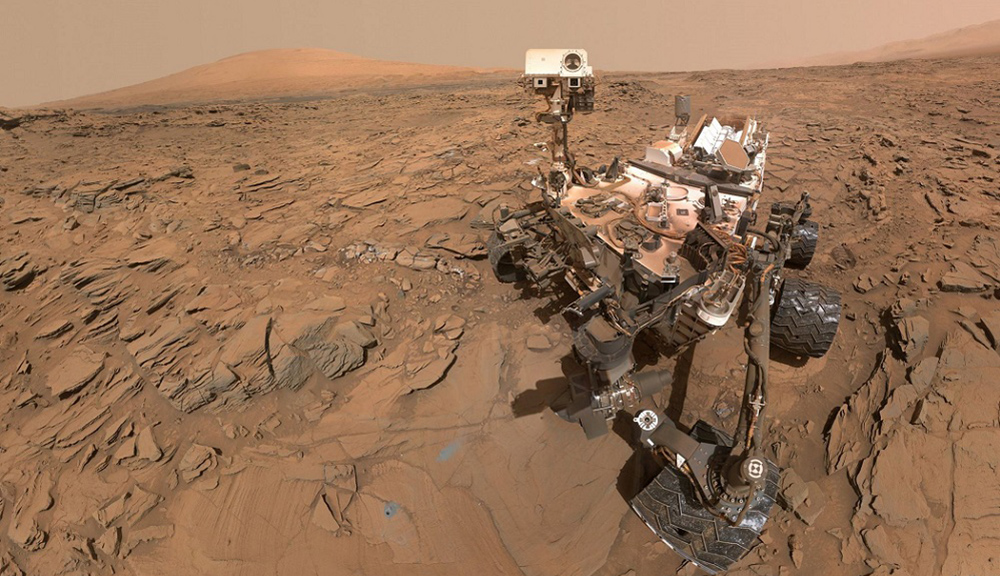Earlier this week, NASA's Curiosity Mars rover completed its first Martian year—687 Earth days—since landing in August 2012. Today, NASA celebrates the women behind the mission.
NASA's Mars Science Laboratory Project is using Curiosity to assess ancient habitable environments and major changes in Martian environmental conditions. Each of the rover's 10 science instruments has people responsible for evaluating newly received data and planning new activities for Curiosity to perform on Mars. Other scientists participating in operations serve on scientific theme groups that pull together information from multiple instruments and choose priorities for upcoming measurements.
Several dozen people are needed for each day of operating Curiosity on Mars. Today, 101 team members are completing the required tasks here on Earth. This team must plan the rover’s daily activities precisely to fit within available budgets of time, power, and data-downlink capacity.
To celebrate the milestone of the first Martian anniversary, the Curiosity team created "Curiosity Women’s Day" as a way to demonstrate the critical roles that women are playing in this mission, and in space exploration overall.
WPI President Laurie Leshin, a geochemist and space scientist, and a member of the Mars Curiosity team, is joining 73 other women in leading today’s operational roles. As the Long Term Planner for today's shift, President Leshin will provide guidance to the team on how today’s plan fits into the longer term picture of Curiosity's progress toward Mt. Sharp, ensuring the key priorities are included. She will also lead the team's Science Discussion, a forum where new science results are presented and discussed internal to the team to gain greater understanding of the data received.
"Curiosity Women’s Day is a great opportunity to showcase the dedicated women explorers who experience the thrill of discovery with Curiosity every day. I hope it provides inspiration for girls everywhere to understand the universe of opportunity that comes from pursuing STEM education and its resulting career options," said Leshin. "Like WPI's project-based learning approach, work on Curiosity requires sharp STEM skills, but also capabilities beyond science and engineering—collaboration and effective teamwork are key. I am so proud to be a part of the team today and every day."
Today's Mars Curiosity Rover team includes members working in 12 U.S. states, and four other nations: Canada, France, Russia and Spain. Disciplines range from soil science to software engineering, from chemistry to cartography, in duties ranging from assessing rover-temperature data freshly arriving from Mars to choosing where to point the rover's cameras.
Leshin has been involved in the Curiosity project since its inception more than a decade ago. She was a member of the team that first defined Curiosity's scientific objectives, and then successfully competed as a member of two NASA-selected rover instrument proposals to become a permanent part of the mission team. She was at NASA's Jet Propulsion Laboratory in California on August 5, 2012, for Curiosity’s landing on Mars. The landing coincidentally occurred on her birthday.
Prior to serving as WPI's 16th President, Leshin had spent six years as a senior leader at NASA. She joined the agency in 2005 as director of science and exploration at NASA's Goddard Space Flight Center, where, as the head of NASA's largest science organization, she was responsible for the strategic management and organization of more than 300 PhDs working in fields ranging from high-energy astrophysics to climate change. In 2008 Leshin was promoted to deputy center director for science and technology at NASA Goddard and was responsible for the strategy, planning and implementation of 50 earth and space flight projects.
In 2010 Leshin was tapped to join NASA's Exploration Systems Mission Directorate in Washington, D.C., the organization responsible for future NASA human spaceflight activities. As deputy associate administrator, her work involved daily oversight and planning for the implementation of the largest proposed shift in human spaceflight activities since the end of the Apollo program. In that role, Leshin sought to catalyze a worldwide space exploration movement by engaging with international space organizations, and through oversight of development of new technologies and robotic missions—including commercial capabilities for low Earth orbit transport and new technologies that would allow for humans to travel to destinations deeper in the solar system.
NASA's Jet Propulsion Laboratory (JPL) in Pasadena, California, is a division of the California Institute of Technology. JPL built the Mars Curiosity rover and manages the project for NASA's Science Mission Directorate in Washington.
For more information about Curiosity, visit NASA's Mars Mission page and NASA's Jet Propulsion Laboratory page. You can follow the mission on Facebook at http://www.facebook.com/marscuriosity and on Twitter at: http://www.twitter.com/marscuriosity.

